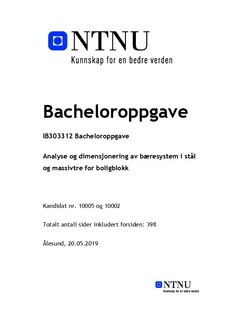Analyse og dimensjonering av bæresystem i stål og massivtre for boligblokk
Bachelor thesis
Permanent lenke
http://hdl.handle.net/11250/2613444Utgivelsesdato
2019Metadata
Vis full innførselSamlinger
Sammendrag
Laminert tre, også kalt massivtre er et relativt nytt konstruksjonsmateriale for fleretasjes bygg. Det er lameller satt sammen til elementer ved bruk av lim, enten parallelt eller ortogonalt på hverandre. Massivtre gir muligheter til å redusere CO2-utslipp i boligbygg, sammenlignet med betong. Utfordringen er at kunnskapen til denne alternative metoden å bygge på ikke er godt nok utredet.
Bacheloroppgaven har som hensikt å sammenligne massivtre og plasstøpt betong i en 14. etasjes bygning. Hovedfokuset er å analysere og dimensjonere konstruksonen for vindkrefter og trykkrefter i bygget ved bruk av FEM-Design, Lastberegning og BTSNITT. Løsningen i massivtre er modellert i Revit Structure og brukes til å sammenligne pris og CO2-utslipp for de to bæresystemene.
Resultatene fra denne oppgaven viser at så komplekst bygg i massivtre vil føre til at søyler og bjelker blir overdimensjonert pga. symmetriens krav. Samtidig er dekker og vegger i massivtre av en slik dimensjon at de greier å ta opp store trykk- og vindkrefter. Plasstøpt betong benytter ikke bjelker, og har færre søyler. Det er her hovedforskjellene mellom de to byggemetodene ligger. Kvadratmeterprisen for massivtre er vesentlig dyrere enn plasstøpt betong. Dette fører til en prisforskjell for råbygget som viser at plasstøpt betong er vesentlig billigere enn massivtre. En av fordelene med massivtre er at det fremstår som mer klimavennlig enn betong. Laminated timber, also called solid wood, is a relatively new material for constructing multi-storey buildings. It consists of lamellas which is combined together with glue. The lamellas can be glued together either orthogonally or paralell to each other. Building constructions with solid wood instead of concrete can possibly reduce the CO2 emissions. The challenge related to this construction method is the lack of knowledge about the subject.
The intention of this bachelor thesis is to compare the materials solid wood and concrete in a 14-storey building. The main intention is to do a structural analysis of the construction with respect to internal forces and forces caused by wind with appliance of the programs FEM-Design, "Lastberegning" and BTSNITT. The support system is modeled in Revit Structure. This model was used to determine CO2 emissions and prices which were used in the comparison of the two support systems.
The results for this bachelor thesis shows that in such a complex construction in solid wood, will lead to oversizing of beams and columns. Meanwhile, CLT-elements are sized to withstand the inflicted forces. The support system made of concrete does not require beams. It also requires less columns. That makes the main difference between these two support systems. The price of solid wood is considerably higher than the price for concrete. This leads to a big difference in the price differance between the two support systems. One of the advantages of using solid wood is the fact that it appears more environmentally friendly.
